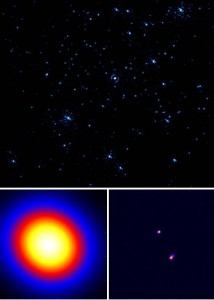SATURDAY, 5 FEBRUARY 2011
The first images obtained by the array cover an area of the sky equivalent to a thousand full moons, and capture a bright radio quasar, known as 3C196, located in a galaxy far far away; in fact 6.9 billion light-years from Earth. The images also show a stunning variety of objects surrounding the quasar. Because of the unique set-up of the telescopes, distant objects can be revealed with a resolution as fine as 0.2 arcseconds, approximately 1/10,000 of the diameter of the full moon. Even the Hubble Space Telescope can only resolve one object when it focuses on 3C196, whereas LOFAR reveals two main bright spots. This will help scientists learn much more about deep cosmology, but the telescopes will do more than look into the furthest and youngest parts of our Universe; they will also be used to monitor the Sun’s activity, study planets and record geomagnetic storms here on Earth.The addition of the Chilbolton Observatory in Hampshire to the other European telescopes makes the Low Frequency Array almost 1000km wide, the largest telescope in the world [1]. The array’s resolution and sensitivity will only get better as the Swedish telescopes are added later this year.
Written by Robert Jones

